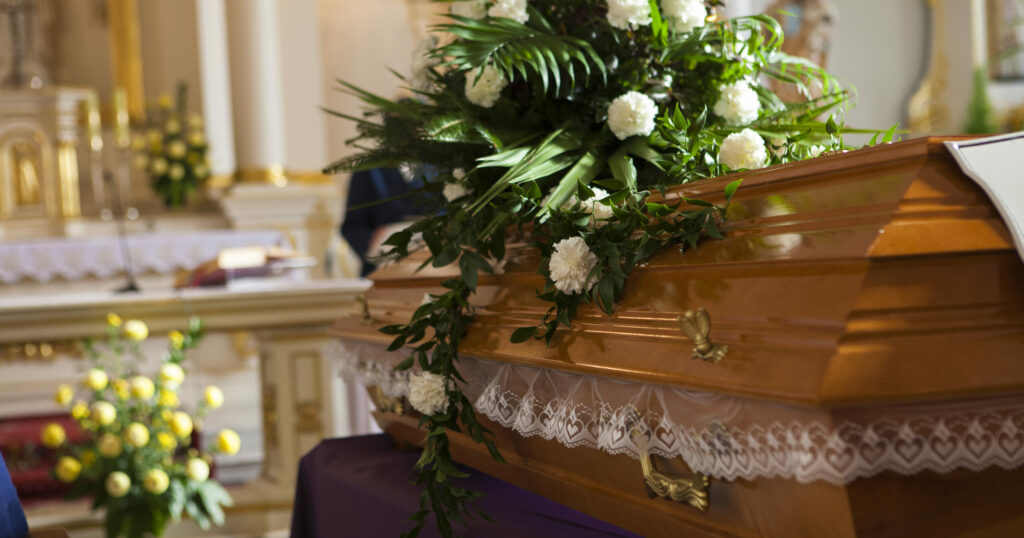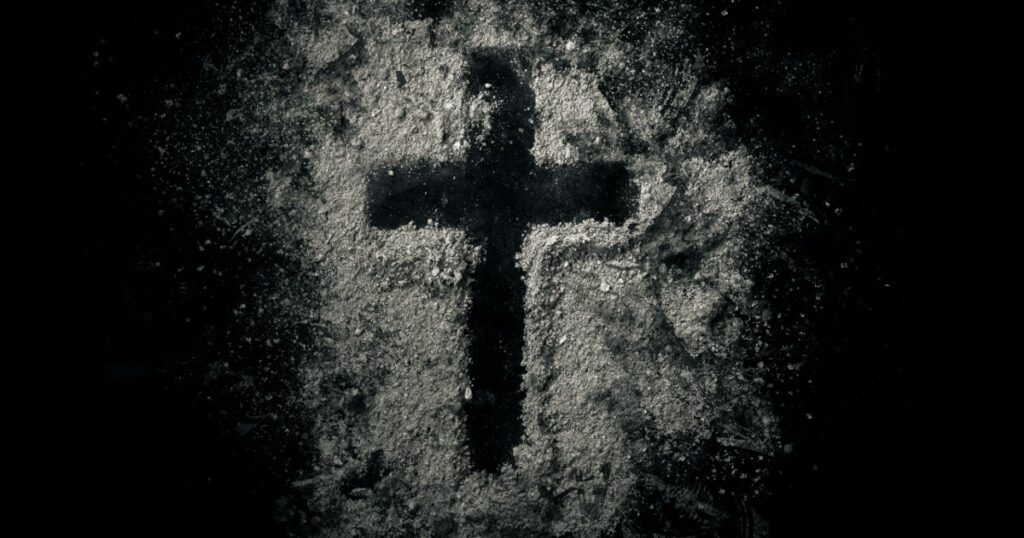By Bryan Wolfmueller
“The funeral service is for the living, not for the dead.” How often I have heard this as a pastor. My usual response, if only in my head, wonders, “Then why is there a corpse in the sanctuary?”
The funeral service is certainly for the living, but it is also for the dead. The rite of Christian burial is often the last good work the Lord permits us to do for our beloved friends until we meet them again in the resurrection. In the wonderfully unique funeral liturgy, we serve our departed brothers and sisters by honoring their mortal remains and putting them safely to rest, awaiting the promise of the resurrection. Consider the confession made by certain elements in the funeral rite.
The draping of the pall
The funeral service begins with the remembrance of Baptism in the draping of the pall. The pastor and congregation read responsively from Romans 6:4, where Paul reminds us that our Baptism is a burial with Christ: “We were buried therefore with him by baptism into death, in order that, just as Christ was raised from the dead by the glory of the Father, we too might walk in newness of life.” Here we remember together that our burial completes our Baptism. We die in Baptism, and in death the glorious promises of our Baptism — deliverance from sin, death and the devil — are delivered to us.
When available, the casket is covered with a funeral pall, reminding us that the dead in the Lord are covered in the righteousness of Christ. Revelation 7 gives us the beautiful vision of the holy martyrs wrapped in resplendent robes, bleached white and perfectly cleansed by the blood of the Lamb, and we rejoice that in life and death we are covered with the forgiving and cleansing blood of Jesus.
The funeral collect
It has become fashionable to call a funeral something seemingly more upbeat, such as a “celebration of life.” This new term has several problems, but chiefly this one: It puts all our joy behind us, in the past. A celebration of life celebrates what was, but when we gather for a Christian funeral, we celebrate what God has done, what God is doing in the present and what God will do in the future. Christians are not dead, but while their bodies sleep, they eagerly await the resurrection of the dead. They have passed from death to life (John 5:24). All who believe in Christ shall live forever (John 11:25–26). Let it be said plainly: Death is not the end.
Therefore, when Christians gather at a funeral, we have more than the past to think about. We rightly celebrate the marvelous gifts the Lord gives to His people: the gift of Holy Baptism, the body and blood of Jesus, the good works that the Lord permits the saints to do in service to their neighbors and their families, and all of the other marvelous treasures and gifts the Lord lavishes upon us in this mortal earthly life. We also celebrate the Lord’s gifts that do not end when we die.
St. Paul says that to be absent from the body is to be present with the Lord (2 Cor. 5:8). What great wonder and comfort these words impart. The funeral service confesses that our loved one is present with the Lord, enjoying His glory, seeing His face, delighting in His mercy. And there is more. The Lord has even more gifts to give to the blessed dead, namely the resurrection of the body and life everlasting in the new heaven and earth where the righteous will dwell:
What is it that he has wrought by his resurrection? He has destroyed sin and raised up righteousness, abolished death and restored life, conquered hell and bestowed everlasting glory on us. These blessings are so incalculable that the mind of man hardly dares believe that they have been granted to us. (Martin Luther, “Fourteen Consolations,” LW 42:164)
The funeral collect assures us of these truths. It reminds us that we do not gather for a mere recounting of the earthly accomplishments of the dead but to give thanks to God for His works, which are new every morning. Just as we rejoice in the gifts that the Lord Jesus gives in life and death to our beloved, we also remember that the same Jesus loves us as well and has those same gifts for those gathered in His name.
Simeon’s Song
The song of St. Simeon from Luke 2 is used often in the prayers of the church. The Lord had promised old man Simeon that he would see the Messiah before his own death. When Mary and Joseph brought 40-day-old Jesus to the temple, Simeon rejoiced that the Lord had kept His promises. He took the blessed child in his arms and sang, “Lord, now You let Your servant go in peace; Your word has been fulfilled. My own eyes have seen the salvation which You have prepared in the sight of ev’ry people” (LSB, p. 165). We sing this hymn in the service of Compline when the sun sets and we prepare to close our eyes for sleep. We sing this hymn in the Divine Service after we have taken into our hands and mouths the body and blood of Jesus, together with the promised forgiveness of sins. And we take these words on our lips in the funeral service, knowing that by faith our beloved dead were ready to depart in peace, and that we, too, are ready.
I have often heard people say that they are not ready to die. It is true that many of us still have long lists of what we would like to accomplish, but this will be as true at your last hour as it is while you read this article. Your work on earth is never done. Being ready to die is not about accomplishing everything on your bucket list. Being ready to die is having faith in Jesus. Being ready for the Judgment Day is trusting His death and resurrection for your salvation. If you believe in Jesus, you are ready to die — even if you do not think so.
At the funeral, then, we sing with Simeon as a confession of faith, knowing that Jesus has prepared a place for us, and when He is ready for us, He will bring us to that glorious eternal home.
A word about the committal rite
We may be tempted to forget about the resurrection of the body. Some think that eternal life is their disembodied souls floating around in glory. That is simply not the case.
On the Last Day, Jesus will stand on the earth and call every body of every person who ever lived up out of the grave and gather them before His throne in judgment. The wicked will be condemned to everlasting death, and the children of God will be received into everlasting glory (John 5:28–29).
One day, the great Last Day, your grave will be as empty as the grave of Jesus. One day, the eyes that you are using to read this article, the very same eyes, will gaze upon the beauty of Jesus and see on His face an undeserved smile (Job 19:26–27; Rev. 22:4). One day, your body, now sick and dying and full of temptation and weakness, will rise in glory, strength and immortality (1 Cor. 15:42–44).
The graveside liturgy powerfully preaches these truths. We hear Jesus’ words: “Unless a grain of wheat falls into the earth and dies, it remains alone” (John 12:24). We hear St. Paul’s glorious crescendo, where he mocks death, saying, “O death, where is your victory?” (1 Cor. 15:55). We hear the letter to the Thessalonians where St. Paul comforts us with the knowledge that the dead and the living will both be lifted up to meet the Lord in the air (1 Thess. 4:17).
In the collect, the pastor prays to consecrate the grave: “By Your three-day rest in the tomb You hallowed the graves of all who believe in You” (LSB Agenda, p. 128). If Jesus died and was buried, it is no shame for the followers of Jesus to die and be buried. We stand by the gaping, devouring darkness of the grave and sing hymns of the resurrection, of the triumph of Jesus over death, knowing that the believer’s grave is only a momentary resting place until the trumpet sounds awaken us. “Death is destroyed. The cross has triumphed over it. It no longer has any power but is truly dead.”[1]
This fallen world knows nothing of resurrection, and we are tempted to forget it as well. The funeral liturgy grounds us in our conviction that we are not only believers in the resurrection of the body, but soon to be participants in the same.
“Blessed are the dead who die in the Lord” (Rev. 14:13).
[1] St. Athanasius, On the Incarnation of the Word, in Day by Day with the Early Church Fathers: Selected Readings for Daily Reflection (Hendrickson, 1999), 34.
This article originally appeared in the September 2021 issue of The Lutheran Witness.






Is there anything in the Lutheran doctrines that would make a member of the LCMS choose traditional burial vs cremation that would follow a traditional funeral service ?
Nothing in LCMS doctrine would state one way or the other. However, I would argue that burial makes a better confession of the body that God has created. The burning of the body has very few positive examples in the Scripture; it’s almost always a consequence of God’s wrath. When we bury a body, I believe we are making a better confession that God has redeemed this body and this body is worthy of our respect as a creation of God. Furthermore, the burning of the body often has connotations in many world religions with the release of the spirit, connotations that are decidedly un-Christian. It’s something to keep in mind.
Thank you for the article, I enjoyed it. I am concerned that the 3rd paragraph might be misinterpreted by unbelievers or new believers. That paragraph quotes Romans 6:4…”we too might walk in the newness of life.” The word might suggests that you may or may not. I have looked at 5 different translations and all of them use a more positive word than “might”. I just concerned that such a weak word could lead some to misinterpret it.
Thank you so much for sharing this article. I now have a better understanding. Reading this gave me great comfort and joy.
Thank you and God blessings!
Denise Parker
While some may believe that the word “life” in the phrase celebration of life only refers to one’s earthly life, I do not. As believers we know that Jesus spoke of the abundant life that we have in and through Him. Therefore, our celebration is one that recognizes the abundant life that begins in Christ and continues through eternity. This is a true celebration!
As a retired Funeral Director, having heard this message many times, it is so GREAT to hear it again and again, it make my heart jump with Joy, in anticipation …..Thanks, Pastor
How does cremation enter into this service??
Cremation, much like burial is a disposition of the body. That means that it is the final part of the service offered. A funeral service can and should precede burial or cremation. Most funeral directors have cost effective alternatives to purchasing a traditional funeral, like specific cremation caskets, for those who feel a traditional funeral is cost inhibitive.
The funeral rite stands apart from burial or cremation and should be used in conjunction with either, providing committal prayers for the body before final disposition.
Decomposition and cremation are the same process of oxidation, just one is accelerated. Wherever I have lived, cremation is thousands of dollars cheaper and is a good alternative when the the body is going to be interred in another State. I have presided at funeral ceremonies with a casket and with cremains in an urn. The body of the deceased is present in both.
That’s not exactly correct. In burial, they do not grind up one’s bones and dye them to match the ashes. The cost for burial is because of the preservation of the body for burial. This was not always done. Historically, burial is what Christians did because Christ still will use our bodies when He returns. Pagans burned their dead. Christians burning the body is a recent trend, which is very lamentable.
Surely the dead do not need anything from us.
We, however, benefit much by gathering to
mark their departure,
mourn their absence,
comfort one another at their passing,
celebrate the evidence of God’s grace in their lives,
express our gratitude for the blessings that came through them, and
anticipate our heavenly reunion with them and all the saints
because of Christ.